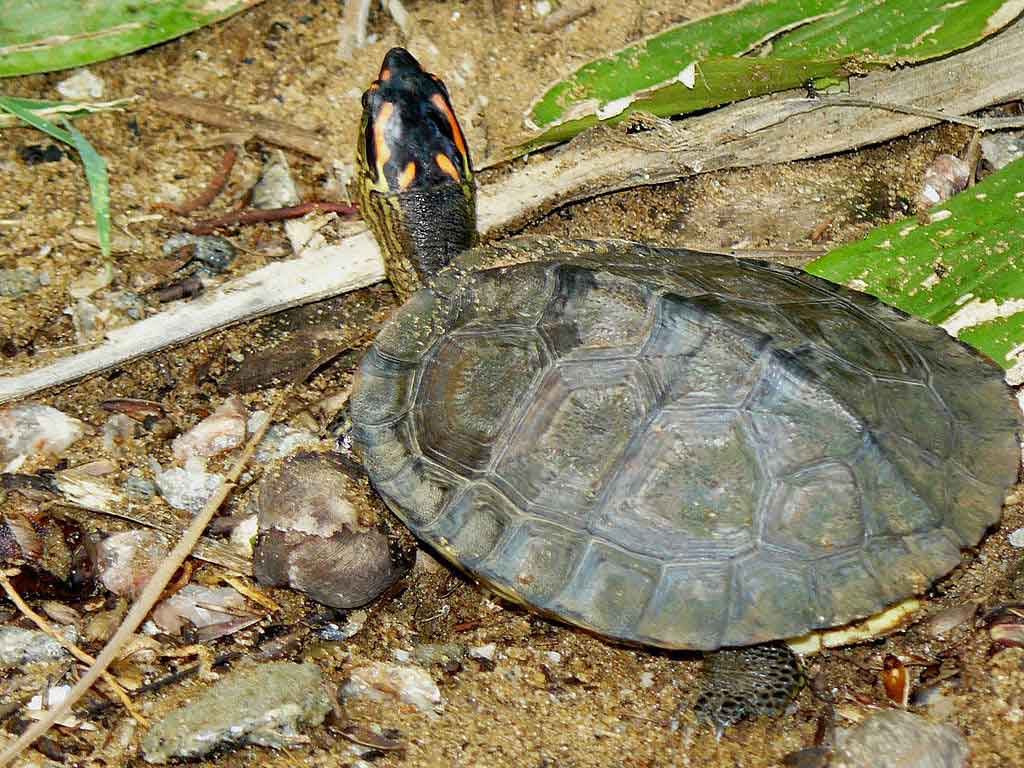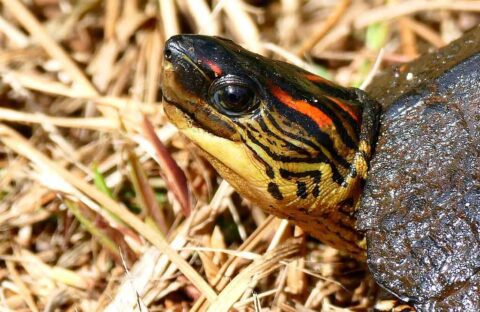
Content |
|---|
Origin / Distribution
The name Rhinoclemmys is derived from the Greek words rhinos (nose, snout, bill, bill) and klemmys (Turtle, Turtle). The name alludes to the protruding snout that some individuals of the type species have..
The Spot-legged wood turtle (Rhinoclemmys punctularia) It is distributed in eastern Colombia., Venezuela, Trinidad, Tobago, Guyana, French Guiana, Suriname, NE of Brazil (Tocantins, For, amazon, Bay, maranhão, to the lower course of the Tapajós River, Rio de Janeiro)
Characteristics / Appearance
The shell is dark brown to black.. Limbs are orange-yellow with scattered black spots. The male is slightly smaller than the female and has a longer, slightly concave plastron and thicker tail.. Middle dorsal keel. red head pattern, yellow or green formed by two longitudinal or horseshoe-shaped stripes. Heavily webbed feet.
Habitat

It is a semi-aquatic species. Lives most of the time in swamps, coastal streams and marshes. In Brazil it lives along the coast of Pará and in open areas along the Amazon River to the lower Tapajós.. Avoid high salinity and strong currents.
Food
Omnivores, seek both animal and plant foods. Foraging and feeding can occur both in water and on dry land.
while they feed, they bite into their food using their front limbs not only to pull and break larger amounts of food, but also to maneuver the food in their mouths.
Reproduction
They lay an average of two very large brittle-shelled elongated eggs. They make several layings in a season. The incubation period can last up to three months.. Sex is determined by temperature. The eggs are covered with leaf litter or hidden among vegetation and roots..
Behavior
Mainly active at night, but is known to bask and be active during the day.
Threats to the species
This species is consumed only locally, but there is evidence that it is widely consumed or kept as a pet and sold on the black market.
It was classified in 2012 like least concern in the new Scientific Assessment of the Risk of Extinction of the Brazilian Fauna. To date, it has not been necessary to create any conservation program for this species.
The "Spot-legged wood turtle" in captivity
It is a rarely imported species., so there is not much information about their care in captivity.
Aquaterrarium
For proper maintenance and care of the Spot-legged wood turtle, an aquarium with an integrated terrestrial part or an aquaterrarium is recommended. The aquarium must have a rim length of at least 150 cm.. The substrate of the aquatic part must be designed as a tropical forest. The lush plantation, foliage and humus can serve you.
The Spot-legged wood turtle It is native to tropical regions.. So, it is mandatory to have a heated aquarium. Reptiles prefer a water temperature between 25 and 30 degrees centigrade with a pH value between 6,0 and 8,0. It is advisable to install a UV lamp so that the turtles sunbathe.
Under no circumstances will we let these turtles hibernate. If temperatures drop below 20ºC, may start to show symptoms of breathing problems.
Buy one "Spot-legged wood turtle"
The price of a "Spot-legged wood turtle" at the exotic animal market, ranges between 90 – 120 EUR.
Imported animals must be kept in quarantine, and be dewormed.
Videos "Spot-legged wood turtle"
|
|
|
|---|
Alternative names:
1. Spot-legged wood turtle, Painted wood turtle (English).
2. Tortue spot-jambes, Tortue ponctulaire (French).
3. Guyana-Erdschildkröte (German).
4. Aperema, Tartaruga-de-patas-malhadas (Portuguese).
5. "Tortuga de patas moteadas", Tortuga Cabeza pintada Guayana, Tortuga de Patas Punteadas, Morrocoy negro (español).
